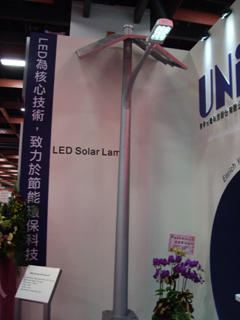Relatively Higher Prices of LED Lights Stop Their Mainstreaming
2008/07/11 | By Ken LiuLED lighting's main focus will continue to be various commercial applications, a belief advocated by market watcher M.J. Huang, who also says that such more energy-efficient lighting will not likely replace traditional ones to become mainstream in residences in the short-term. The reason: Solid-state LED lights retail for considerably more than traditional ones, such as incandescent and fluorescent lights. For example an online site sells a 2W MR16, 21-module LED bulb for US$20; while a name-brand 40W incandescent bulb would be priced about US$1 or less in Taipei, Taiwan, and a 28W Japanese-branded compact fluorescent bulb on the same site is US$13.
"One reason is that commercial lighting, despite being a relatively modest proportion of overall usage that consumes disproportionately sizable energy, is not driven by the incentive to build in cost-effectiveness as businesses are seen to be able to shoulder higher prices. But commercial lighting is relatively expensive when considered in terms of personal expenditure," says Huang, a market research fellow at the Industrial Economic Knowledge Center (IEK) of the Taiwan government-backed Industrial Technology Research Institute (ITRI).
Huang goes on that LED lighting is relatively expensive not only because of the costly LED emitters but also the higher cost to build certain unique lighting fixtures for commercial applications. "Most traditional lamps are very affordable now. But LED ones can hardly replace traditional lamps used in homes in the short-term unless official incentives as subsidies are offered," she says.
The market researcher believes that LED lamps will gradually penetrate residential bathrooms and kitchens, where the less-expensive low-power emitters are acceptable.
US$980M. Market by 2011
Huang projects the LED-lighting market to total some US$980 million worldwide by 2011, mostly driven by architectural and commercial applications. She attributes such market growth to impressive improvements in LED technology, as well as an urgent need to develop more energy-efficient lighting as fuel prices escalate.

She notes that lighting overall burned up 19% of electrical power worldwide in 2005, with inefficient incandescent lamps, for example, consuming a significant portion. The white-burning lights, she says, still are installed in about one of three sockets in service, but gives off only eight to 25 lumens of illumination for each watt. Plus 90% of the incoming energy is typically output as sensible heat in a light bulb, not as desirable light.
The research estimates that the global lighting market will likely surge to US$90.4 billion by 2010 from 2005's US$74.6 billion as a result of continuous economic growth, which drives construction and manufacturing as well as further urbanization to bring in closer the hinterlands.
Literally lighting the road to Taiwan government's plan to build LED as a green sector, LED-lighting manufacturer Alliance Optotek Corp. believes that developing LED streetlighting will help further commercial applications of such energy-efficient lamps. The company is an LED-lighting joint venture of China Electric Mfg. Co., Ltd., United Microelectronics and China Steel Corp. of Taiwan.
Fueled by Official Pledge
The government has pledged to replace 430,000 incandescent traffic lights with LED lamps over three years, as well as change 1.35 million mercury streetlights to LED types gradually. "Such ambitious promise will, we believe, help to launch the LED streetlighting market at home this year," estimates F.C. Peng, vice president for marketing at Alliance.
Taiwan-based LED-lighting manufacturers, Peng suggests, would do well to take advantage of the vast mainland Chinese market to develop the commercial-lighting business. Such advice is backed by the fact that the mainland authorities began pushing LED streetlighting in the second half last year as part of its effort to overcome power shortage. China alone is the world's biggest potential market for streetlights, with some 15 million in service.
Industry watchers in Taiwan point out that LED makers on the island are competitively positioned to explore the China market: they have not only set up complete industrial chains spanning up-, mid- and down-stream segments, but also are relatively well informed about the vast market across the Strait.
A few of the leading Taiwan-based makers of LED streetlights are Alliance, Advanced Thermal Devices Inc., Thermoking Technology International Inc., and NeoPac Lighting Inc.




